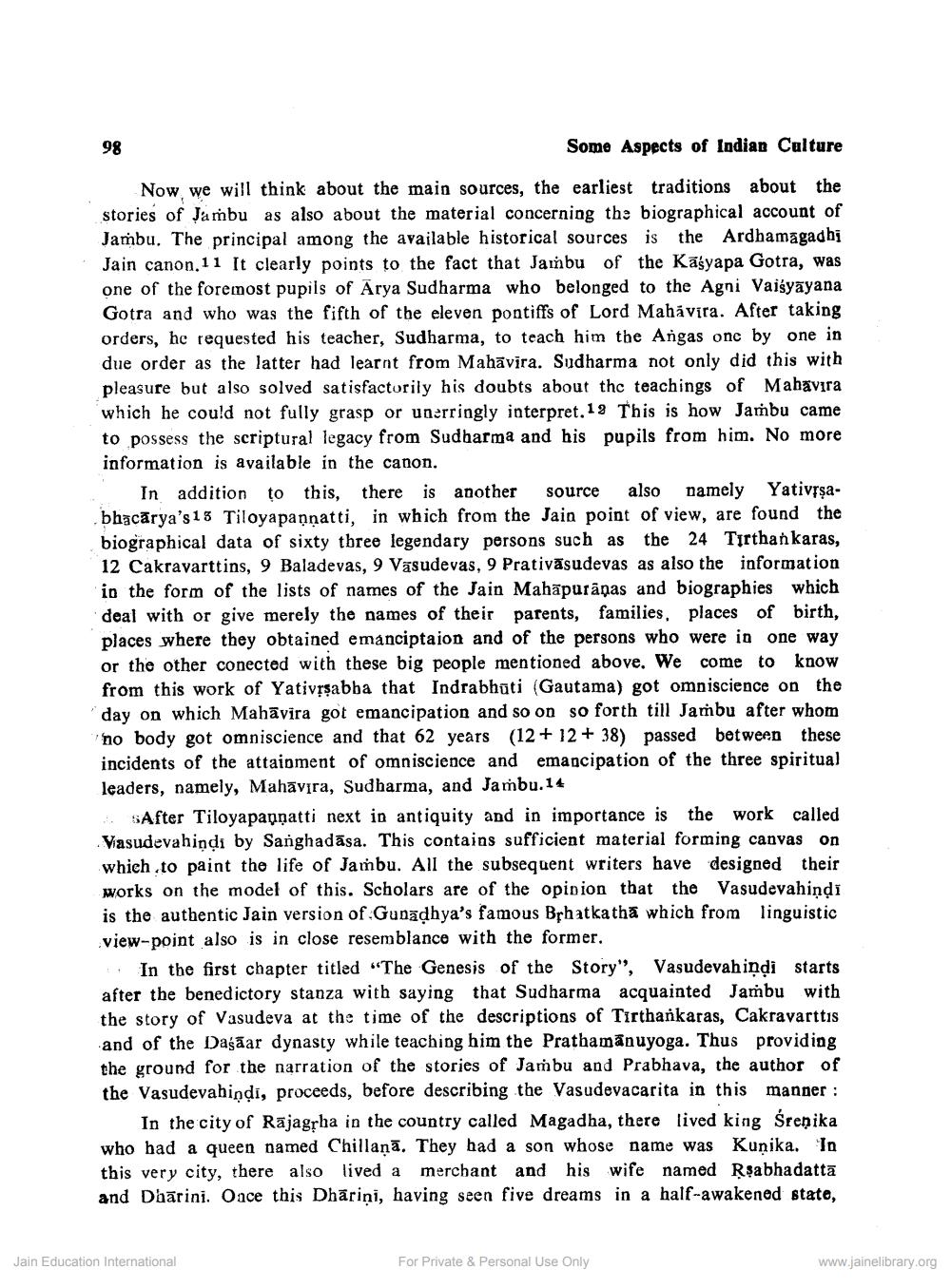________________
Some Aspects of Indian Culture
Now, we will think about the main sources, the earliest traditions about the stories of Jambu as also about the material concerning the biographical account of Jambu. The principal among the available historical sources is the Ardhamagadhị Jain canon. 11 It clearly points to the fact that Jambu of the Kāsyapa Gotra, was one of the foremost pupils of Arya Sudharma who belonged to the Agni Vaiśyāyana Gotra and who was the fifth of the eleven pontiffs of Lord Mahavira. After taking orders, he requested his teacher, Sudharma, to teach him the Angas one by one in due order as the latter had learnt from Mahāvīra. Sudharma not only did this with pleasure but also solved satisfactorily his doubts about the teachings of Mahavira which he could not fully grasp or unerringly interpret.13 This is how Jambu came to possess the scriptural legacy from Sudharma and his pupils from him. No more information is available in the canon.
In addition to this, there is another source also namely Yativssabhacārya's13 Tiloyapaņnatti, in which from the Jain point of view, are found the biographical data of sixty three legendary persons such as the 24 Tirthankaras, 12 Cakravarttins, 9 Baladevas, 9 Vasudevas, 9 Prativāsudevas as also the information in the form of the lists of names of the Jain Mahāpurānas and biographies which deal with or give merely the names of their parents, families, places of birth, places where they obtained emanciptaion and of the persons who were in one way or the other conected with these big people mentioned above. We come to know from this work of Yativrsabba that Indrabhūti (Gautama) got omniscience on the day on which Mahāvīra got emancipation and so on so forth till Jambu after whom no body got omniscience and that 62 years (12 + 12 + 38) passed between these incidents of the attainment of omniscience and emancipation of the three spiritual leaders, namely, Mahavira, Sudharma, and Jambu.14
SAfter Tiloyapannatti next in antiquity and in importance is the work called Vasudevahindi by Sanghadāsa. This contains sufficient material forming canvas on which to paint the life of Jaṁbu. All the subsequent writers have designed their works on the model of this. Scholars are of the opinion that the Vasudevahindi is the authentic Jain version of Gunādhya's famous Bphatkathā which from linguistic view-point also is in close resemblance with the former. 1. In the first chapter titled "The Genesis of the Story", Vasudevahindi starts after the benedictory stanza with saying that Sudharma acquainted Jambu with the story of Vasudeva at the time of the descriptions of Tirthankaras, Cakravarttis and of the Dasar dynasty while teaching him the Prathamānuyoga. Thus providing the ground for the narration of the stories of Jambu and Prabhava, the author of the Vasudevahindi, proceeds, before describing the Vasudevacarita in this manner :
In the city of Rajagrha in the country called Magadha, there lived king Śrenika who had a queen named Chillaņā. They had a son whose name was Kunika. In this very city, there also lived a merchant and his wife named Rşabhadattā and Dharini. Once this Dhāriņi, having seen five dreams in a half-awakened state,
Jain Education International
For Private & Personal Use Only
www.jainelibrary.org




